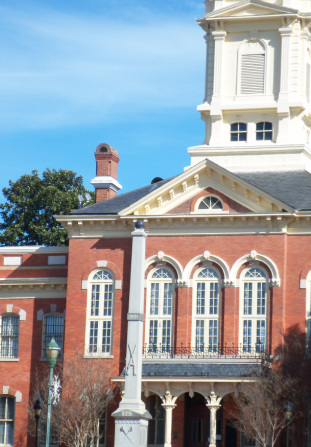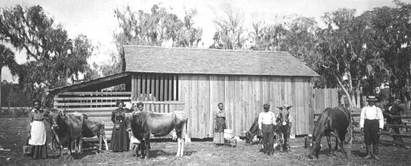Funding and Organization

Old Monroe Courthouse (Photo by Autumn Smith)
After Washington died, the philanthropist established the Julius Rosenwald Fund, with the goal to build schools collaboratively with communities, in order to build lasting cooperation between the races. Communities would receive funds only with matching monies, work or land from both races. "N.C. Director of Negro Education Nathan Carter Newbold summarized the fund’s importance when he proclaimed: ‘School Superintendents, Jeanes Teachers, General Education Board Agents, County Training School Principals, and people, all seized upon the Rosenwald school as something visible, tangible, an evidence of progress in Negro education that could not be gainsaid. It probably was the ‘missing link’ all agencies needed to round out a complete program for Negro schools" (Hanchett, 1988, p. 400).
Success of the first schools in three states was duplicated across the country, including Union County, N.C. The effects of the schools on the economic well-being of Southern blacks was an increase in income of 35 percent in comparison to whites, according to a report published by the Federal Reserve Bank of Chicago in 2009. (Aaronson & Mazumder, The Impact of Rosenwald Schools on Black Achievement., 2009).
In North Carolina, state budget records indicate that funds for over 800 schools were provided to build Rosenwald schools between 1918 and 1929 (Kendrick, 1993). In 13 states, there were 5,300 schools built with Rosenwald funds. Teachers were paid with funds setup by many philanthropists. One fund was established by a Quaker woman, Anna T. Jeanes, who left a million dollars to educate the disenfranchised race (Lehman, 2003). Matching funds were raised from the public tax monies, land donations from churches and individuals, and labor from the parents of students who would benefit.
Success of the first schools in three states was duplicated across the country, including Union County, N.C. The effects of the schools on the economic well-being of Southern blacks was an increase in income of 35 percent in comparison to whites, according to a report published by the Federal Reserve Bank of Chicago in 2009. (Aaronson & Mazumder, The Impact of Rosenwald Schools on Black Achievement., 2009).
In North Carolina, state budget records indicate that funds for over 800 schools were provided to build Rosenwald schools between 1918 and 1929 (Kendrick, 1993). In 13 states, there were 5,300 schools built with Rosenwald funds. Teachers were paid with funds setup by many philanthropists. One fund was established by a Quaker woman, Anna T. Jeanes, who left a million dollars to educate the disenfranchised race (Lehman, 2003). Matching funds were raised from the public tax monies, land donations from churches and individuals, and labor from the parents of students who would benefit.
Support from the white community came in the form of taxes or land donations. Despite poverty in the African-American community, 18 schools were built in Union County for minority students with matching funds from county taxes. Support from African American citizens raising pennies and nickels with "box parties," dedicating an acre of cotton or a stand of lumber to the cause (Hanchett, 1988).
Not all efforts to build were successful. In Marshville, Rosenwald funds were withdrawn from a project for which only desks were provided. Paint and blackboards were absent, according to records of county agent Dr. George E. Davis in March 1929 (Hanchett, 1988). The building must have been planned to replace an existing school because Virginia Kendrick dates state funding for the Marshville school as 1919-1920 in The Heritage of Union County, North Carolina, Old Monroe Courthouse.
Not all efforts to build were successful. In Marshville, Rosenwald funds were withdrawn from a project for which only desks were provided. Paint and blackboards were absent, according to records of county agent Dr. George E. Davis in March 1929 (Hanchett, 1988). The building must have been planned to replace an existing school because Virginia Kendrick dates state funding for the Marshville school as 1919-1920 in The Heritage of Union County, North Carolina, Old Monroe Courthouse.

